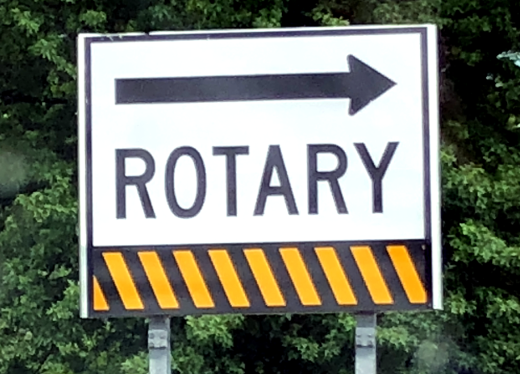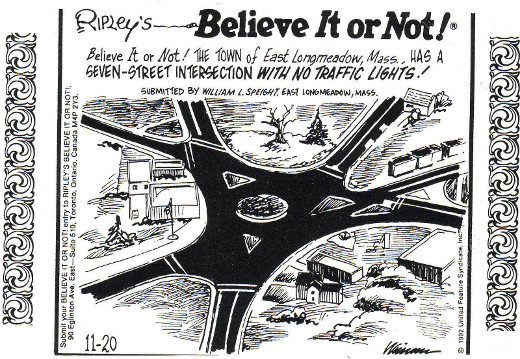Wisconsin Roundabouts To A Native Massachusetts Rotary Driver

On a recent trip back to the Boston area I rented a car for the weekend, and as I slipped behind the wheel I also slipped back into Boston driving mode. Or at least as much as I could, as living in the Midwest for the last 15 years has dulled some of my Massachusetts driving edge. As I positioned my hands on the wheel, with my thumb on the horn, I hit the winding roads which were originally blazon by cattle, wagons and marching soldiers. And along the way, I went through a few rotaries.
Rotaries are what they (I?) call out East what I see as a growing occurrence locally here in Northeast Wisconsin, the roundabout. Where they are not anywhere a new invention, and certainly not one solely in the US, roundabouts are being put into place in the area that I now call home, and have been put into place, as the next coming of driving. And they are still going up on roads and intersections.
For someone who has been driving through this type of traffic pattern since I have been driving, I want to share my insights on them from Right to Mid Coast, and how I don’t see what the big deal is.
You Spin Me Right Round, Baby
My definition of a rotary – or roundabout – is a way for traffic to flow through an intersection of 2 or more streets without the need for a traffic light. Cars will approach the rotary, pause for incoming traffic, enter the rotary going around to the right of the center of the rotary, then exit it at the appropriate street. It of course requires everyone to obey these simple rules, and nobody or their cars gets hurt. Simple enough, right?
Growing up in Massachusetts, where most cities and towns predate most of the states in the US, these rotaries have always been there. Sure, some may have been added over time, but the convergence around a circle to get to the street you are heading was nothing new. Fast forward to the times I have been to Wisconsin prior to moving here last year, I have seen roundabouts being created in certainly the dozens over the years, and I hate to say it but to my amusement as well.
My Rotaries Are Not These Roundabouts
The above photo is from a rotary just north of Boston. It a more modern and much smaller sign, as traditional rotary signs were much wider – sometimes 2 or 3 times the width of this one – and much lower to the ground. In other words, when you approached a rotary, you wouldn’t be able to miss it. There also may be a Yield sign as you approach the rotary, but other than that you won’t see any other special road markings or signage that you were entering or going through a rotary in the Bay State. Why? I don’t recall the specific from the road test manual I studied in the early 1980’s.
Moving about 1,500 miles west, you find the rotaries in Wisconsin. Honestly, they are beautiful, and that goes beyond the landscaping. Overhead and side signage greet you as you approach the roundabout. The markings on the signs correspond to the markings on the road, as the road can flare into 2 or 3 lanes, depending on the intersection, on the options you have for going through the roundabout. These lanes continue through the roundabout until you exit it.
As you exit a roundabout, don’t be surprised if there is another one right next to it. Seriously. A whole, completely new roundabout, covering another set of streets including the one you just came in from the last roundabout. Though I don’t have insight into what the roads looked like previously, likely there was another traffic light, and if you are replacing one, then replace them all? Another scenario is you will have a roundabout at each side of a bridge by a highway exit. This “phenomenon” of adjacent roundabouts is something I still can’t get my head around fully, but of course manage to go through just fine.
Since I have moved here I have observed first hand and thru the media as new roundabouts open. One in particular was added at an intersection of 2 streets that had a high accident volume, presuming the roundabout would lessen or eliminate these accidents. However after it opened accidents continued and I personally observed many close calls going through it. Some say it is due to people’s lack of experience with roundabouts and I would agree with that. Though with the signage and lane markings, what to do is almost spoon-fed to you as you enter.
These Roundabouts Are Not My Hometown Rotary
As you may have sensed from the beginning of this, I laugh a bit about the roundabouts here in Northeast Wisconsin. But I have good reason. Many of these roundabouts are at the intersection of 2 or maybe 3 roads. As you approach a roundabout, even with the well-groomed circular island in the middle, you have a clear view of most all of the traffic that is approaching or coming through the roundabout.
It just so happened I grew up in East Longmeadow, Massachusetts, a suburb of Springfield. Where Springfield is the home of the US’s first armory and basketball, East Longmeadow is home to the wicked fast XLERATOR hand dryer and a rotary that ties together 7 streets. Yes, seven. Maple, Shaker, Prospect, Somers, Pleasant, Elm and North Main. You can see it for yourself on Google Maps if you don’t believe me. Seven streets was enough to get it listed in Ripley’s Believe It or Not, and interestingly the submission was by the builder of most of the homes in the town.

So when you see that car with the Patriots sticker on the back and Wisconsin license plates proceeding through the roundabout with confidence, it didn’t come overnight. When your first driving lesson started on Maple Street and you were headed into the East Longmeadow rotary, you best learn fast.
Deconstructing Roundabouts
The potential for less accidents, faster moving traffic and better fuel economy make roundabouts – and rotaries – a good choice for road improvements. In the short term as roundabout are built there will be both learning and cost curves – the more times you use a roundabout, the better experienced you are with them. But these come at a cost – I saw a new roundabout was well over US$1Million. Hopefully by the time people are used to driving through them the investments by communities in them will have at least broken even.
This is from The Hot Iron, a journal on business and technology by Mike Maddaloni.
Did you enjoy this? Subscribe to The Hot Iron by RSS/XML feed or Read by Email.
Strategize • Technology • (0) Comments • Permalink



